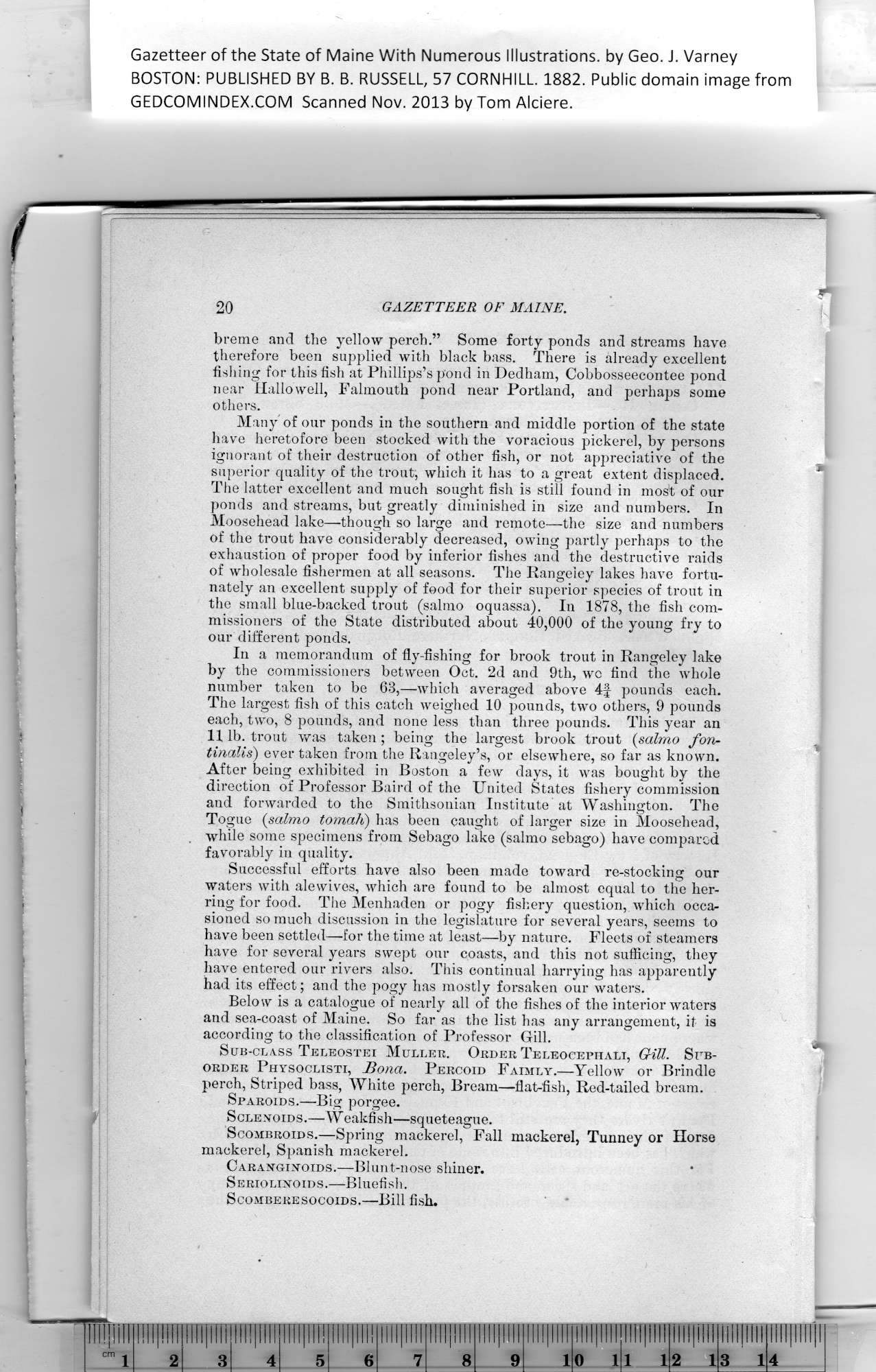|
Gazetteer of the State of Maine With Numerous Illustrations, by Geo. J. Varney
BOSTON: PUBLISHED BY B. B. RUSSELL, 57 CORNHILL. 1882. Public domain image from
breme and tbe yellow perch.” Some forty ponds and streams have
therefore been supplied with black bass. There is already excellent
fishing for this fish at Phillips’s pond in Dedham, Cobbosseecontee pond
near Hallo well, Falmouth pond near Portland, and perhaps some
others.
Many of our ponds in the southern and middle portion of the state
have heretofore been stocked with the voracious pickerel, by persons
ignorant of their destruction of other fish, or not appreciative of the
superior quality of the trout, which it has to a great extent displaced.
The latter excellent and much sought fish is still found in most of our
ponds and streams, but greatly diminished in size and numbers. In
Moosehead lake—though so large and remote—the size and numbers
of the trout have considerably decreased, owing partly perhaps to the
exhaustion of proper food by inferior fishes and the destructive raids
of wholesale fishermen at all seasons. The Rangeiey lakes have fortu-
nately an excellent supply of food for their superior species of trout in
the small blue-backed trout (salmo oquassa). In 1878, the fish com-
missioners of the State distributed about 40,000 of the young fry to
our different ponds.
In a memorandum of fly-fishing for brook trout in Rangeiey lake
by the commissioners between Oct. 2d and 9th, wo find the whole
number taken to be 68,—which averaged above 4f pounds each.
The largest fish of this catch weighed 10 jiounds, two others, 9 pounds
each, two, 8 pounds, and none less than three pounds. This year an
11 lb. trout was taken ; being the largest brook trout (salmo fon-
tinalis) ever taken from the Raugeley’s, or elsewhere, so far as known.
After being exhibited in Boston a few days, it was bought by the
direction of Professor Baird of the United States fishery commission
and forwarded to the Smithsonian Institute at Washington. The
Togue (salmo tomah) has been caught of larger size in Moosehead,
while some specimens from Sebago lake (salmo sebago) have compared
favorably in quality.
Successful efforts have also been made toward re-stocking our
waters with ale wives, which are found to be almost equal to the her-
ring for food. The Menhaden or pogy fishery question, which oeca-
sioned so much discussion in the legislature for several years, seems to
have been settled—for the time at least—by nature. Fleets of steamers
have for several years swept our coasts, and this not sufficing, they
have entered our rivers also. This continual harrying has apparently
had its effect; and the pogy has mostly forsaken our waters.
Below is a catalogue of nearly all of the fishes of the interior waters
and sea-coast of Maine. So far as the list has any arrangement, it is
according to the classification of Professor Gill.
Sub-class Teleostei Muller. Order Teleocephali, Gill. Sub-
order Physoclisti, Bona. Percoid Faimly.—Yellow or Brindle
perch, Striped bass, White perch, Bream—flat-fish, Red-tailed bream.
Sparoids.—Big porgee.
Solenoids.—Weakfish—squeteague.
Scombroid s.—Spring mackerel, Fall mackerel, Tunney or Horse
mackerel, Spanish mackerel.
Caranginoids.—Blunt-nose shiner.
Seriolinoids.—Bluefish.
Scomberesocoids.—Bill fish.
PREVIOUS PAGE ... NEXT PAGE
This page was written in HTML using a program written in Python 3.2
| 